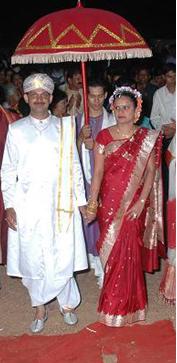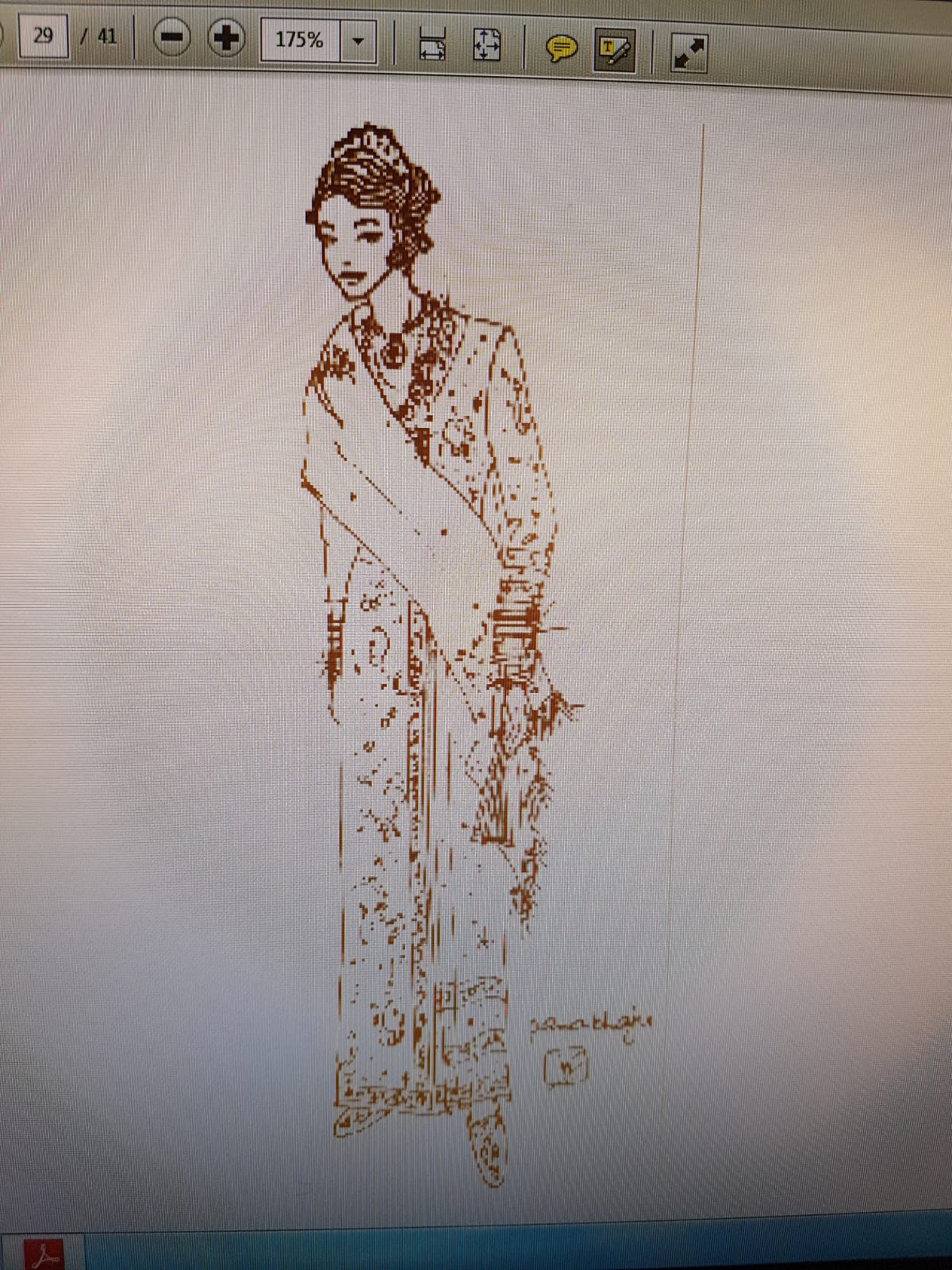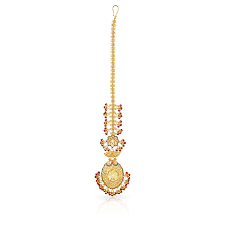STEP 6
Mangalorean wedding garments and ornaments
In spite of extensive research to get pictures and illustrations of bridal garments and jewellery worn in the past by the Mangalorean/South Canerese catholics, I have not had much success. Most of the ornaments were inspired from jewellery worn by mangalorean hindu and Goan jewellery. Hence, some of the pictures illustrated below are just ‘Indicative’ in my pursuit to obtain the actual wedding ornaments’ pictures and will update as I go along.
Then:
Wedding garments
In the early days the traditional wedding dress worn by the bridegroom was a short loin cloth (kachhen or dhoti) with red and gold hem (todop), a shawl to cover his shoulders, a red handkerchief (leis) on the head and a shirt with gold buttons and a coat (kutav). The bridegroom wore a chakrasar-neck chain and a pair of sandals or a pair of socks. The groom also wore the “Urmbal” (head gear). The traditional unbrella used was a big umbrella with 10 sticks “Damaskachi Satri” depicted by the red unbrella.

Traditional wedding costume

Bellevision.com traditional wedding garments
On making enquires with friends I was told by Lydia Vas that her mother, who married in the year 1939 wore a ‘heavy embroidered skirt’ for her wedding and ‘chinelem‘ for footwear. While researching on this topic I came across the “pano bhaju” and “chinelos” which is the attire of Goan catholics and quite believe this could have been the dress adopted by some brides in ealier times due to our Goan history. Her mother-in-law though, wore the kirgi baju.

GoaTourism – Pano Bhaju & Chinelem illustration

Traditional Kirgi Baju

Traditional Kirgi Baju
In fomer days the bride used to wear a “Kirgi” and a “baju”. Kirgi is a piece of cloth 4 feet long and 3 feet broad wrapped waist down around the body. The baju is a long sleeved jacket to cover the upper part of the body and covered with a veil in V shape.
After the wedding ceremony the bride would change into the “Sado” when she gets her pallu “Worl” to symbolise the change from spinster to married.
In today’s day the Kirgi Baju is worn by the bride for her roce and the kirgi is usually made from the bride’s mother’s wedding banarsi saree “sado”.
In later years the wedding dress gradually changed to the bride wearing a white saree but the bridegroom wore the dhoti and kutav.

Bride in white saree
Then & Now:
The traditional wedding saree worn by the bride is known as Sado and is presented by the groom. The second wedding saree is the dharma-sado (also referred to as Sado vailem) which ranks second to the sado, also an expensive saree, and is presented to the bride by her mother/family (in some instances the bridegroom may voluntarily pay for the dharma sado and the sado as it was in my case). The third saree is the “maipano” given by bride’s mother. For my ‘porthapon’ I wore the dharma-sado and then changed into the maipano at my mother’s house.

Sado

Dharma-Sado

Maipano
It was and still is customary to present sarees to the female members of the family and some female wedding guests, especially by the bridegroom and male family members and children and some guests also received presents of clothes.
Now:
Now and in recent years bridegroom wears a suit without hat and the bride wears the white dress. Below are the wedding pictures of my late parents married 63 years ago, my wedding 36 years ago and most recent is my son, but all these weddings took place in Mumbai City hence the western influence however, the tradition of the bride changing into the sado (as in the traditional wedding costume pictures above) was maintained and still continues.
Brides and grooms in Mangalore also have switched to the western style of dress with Sado ceremony.

My parents wedding 1955

My wedding 1982

My son’s wedding 2011
Then:
Wedding Ornaments
It was common practice to call the goldsmiths to the house to prepare the ornaments. The traditional gold ornaments worn by the bride were:
- Pirduk-gold chain with black glass beads with a pendant also called mangalsutra which used to be tied by the mother-in-law. Another form of pirduk was a pendant with a cross studded with precious stones. To the top of the cross was a dove, symbol of the Holy Spirit “minin” and sorpoli worn on a gold chain (without beads).
![Gold_antique_mangalsutra[1]](https://maisrecipes.files.wordpress.com/2018/04/gold_antique_mangalsutra1.jpg?w=410)
Pirduk – Mangalsutra/Karimani

Sorpoli with minin

Sorpoli and Pirduk with Minin (Updated 4th October, 2021)
(Lately made by Mrs. D’souza who was kind enough to share
the picture with me for posting it here for the benefit of my viewers)

Pirduk (Cross pendant) with Minin (Dove)
The cross design was mainly the ‘Trinity cross’ with a dove on top of the cross.

2. Kanti-necklace of gold beads or red coral and gold beads, various types as shown below. Understand these are nowadays usually worn by senior married women.

Coral Kanti

Coral Kanti

Gold oval beads Kanti strung on gold chain

Necklaces usually worn by elderly married women
3. Chakrasar– Neck chain worn by men and chain of small round gold plates woven one into the other and forming a long chain, worn by women (also worn by Hindus).

Chakrasar – neck chain worn by men

Chakrasar – Bride

Lakshmi Sara – Bride
4. Fugador – Necklace of large green stones mounted on gold,

Fugador
5. Kap – Round disc ear ornament inserted into the lobe of the ear. It is still the typical ear ornament for married women in Canara. But in later years the Kudkan became more common, which is a round gold disk surrounded by precious stones.

Kap – Indicative

Kudkan

Kudkan
6. Karap – Inserted in the middle ear with a thin gold chain attached to the hair,
![Earing_with_chains[1]](https://maisrecipes.files.wordpress.com/2018/04/earing_with_chains1.jpg)
Karap – Indicative
Worn on the top of ear, a gold disk surrounded by pearls and attached to the hair by a chain,
8. Kanto – Gold or silver pin with a gold head stuck through a bun at the back of the head.

Kanto – Indicative

Kanto – Indicative
9. Dantoni – Two ordinary pair of combs with the top plated in gold and worn in the head on both sides above her ears.

Dantoni – Indicative
10. Masli-two more combs with a figure of fish in gold inserted in each comb,
11. Bang-gold chain with pendant in the centre of the forehead and hair parting,

Bang (Maang Tikka)

Maang Tikka with chain

Mangalorean Catholic bride wearing Bang with chain
12. Rings – on her hands several rings

Traditional Ring design
13. Bangles – Three sets of gold bangles

14. Red Glass Bangles – plus some red glass bangles which are worn with sado.

Now:
Wedding Garments
Sado, dharma-sado and maipano and additional sarees may be purchased and as tradition dictates some close family female wedding guests are also presented sarees and male guests also receive presents of clothes. For the nuptials a white dress or saree are worn and the changing into the Sado is done mid-way at the wedding reception.
Wedding Ornaments
The basic jewellery is now a modern necklace, gold chain with pendant and bangles, much less jewellery than in the past. The mangalsutra is paid for by the bridegroom which he puts on the bride. The mangalsutra though is simply a symbol of the married state adopted from old hindu traditions and is part of a social custom. The Catholic Church recognises only the “wedding bands” that are exchanged in the church and therefore only the wedding rings are blessed and witnesses testify to having witnessed the exchange of the rings.

Wedding Bands
As explained in “Finalising the alliance – Sairik” the concept of Dowry has now changed from “cash” to “kind” – Gold what the Bride brings with her (based on her financial status) and 50% share of the wedding expenses.

Modern jewellery

Modern Mangalsutra

Modern necklaces
Usually the parents of the bride and groom and some elders from both families go together to pick the bridal sarees and jewellery, an event which would take almost the entire day and also provides a good opportunity to bond with the new relatives.
The brides’ jewellery and the wedding sado (although purchased by the groom is given to the bride for having the blouse etc. tailored) are to be taken to the grooms house by a couple of elders of the brides’ family a day or two before the wedding as “denem“. The denem articles are displayed by the grooms mother to her family and guests and is brought to the church wrapped in a red velvet or satin fabric as these are to be carried to the church alongwith the Jasmine and Aboli (Crossandra) flowers by the bridegrooms family so that they can be blessed during the general blessing at the nuptials and then taken to the reception. The bridegrooms family is responsible for dressing the bride in the sado, flowers and ornaments.

Jasmine mangalore flowers

Aboli flowers
Special thanks to Mrs. Lydia Vas for her valuable input and for sharing some jewellery pictures and Mrs. Diana D’souza for the picture of the bride in white saree. Truly appreciate your efforts. Thanks also go out to Mrs. Janet D’Souza and Mrs. Jenifer Dias for the additional jewellery pictures.
Previous Post:Bachelor Bachelorette Party Bridal Showers
Next Post : Wedding Invitation “Voulik”
References: Severine Silva and Stephen Fuchs & Victor D’sa, S.V.D.: The Marriage Customs of the Christians in South Canara, India, wikipedia, Bellevision, Goa Tourism, Konkani State Vishal Gomantak














![Gold_antique_mangalsutra[1]](https://maisrecipes.files.wordpress.com/2018/04/gold_antique_mangalsutra1.jpg?w=410)


















![Earing_with_chains[1]](https://maisrecipes.files.wordpress.com/2018/04/earing_with_chains1.jpg)

















Recent Comments